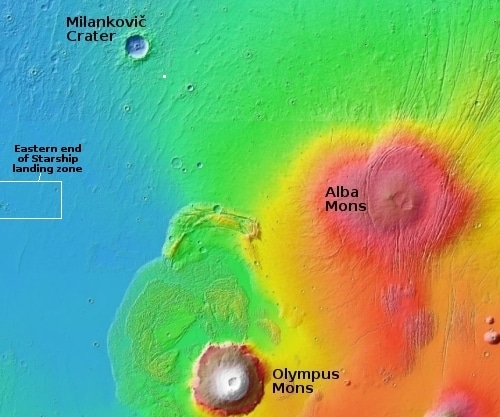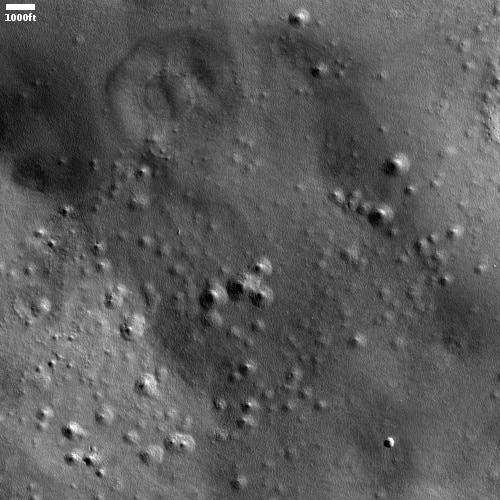A spray of small impacts melting Martian ice?
Cool image time! The picture to the right, cropped and reduced to post here, was taken on March 2, 2023 by the high resolution camera on Mars Reconnaissance Orbiter (MRO), and was taken not as part of any specific research request but by the MRO science team to fill a gap in its schedule while also maintaining the camera’s temperature. Sometimes these somewhat random times show nothing of interest. Sometimes they are fascinating, as in this case.
The photo shows what appear to be a spray of small impacts on an easily melted surface. Imagine spraying hot molten lava on a sheet of ice. Instead of creating a crater with an upraised rim, on impact each droplet would quickly melt a hole.
Did these small impacts all occur at the same time? My guess is yes, based on the overview map below.

The white dot southeast of Milankovic Crater marks this location, which is also at 52 degrees north latitude. The ground here is very likely impregnated with near-surface ice, which would easily melt if hit with a spray of falling hot objects. Moreover, Milankovic Crater is already known to have visible underground layers of ice, revealed on many exposed scarps on the crater floor.
This spray could have come from a rubble-pile asteroid breaking up as its entered Mars thin atmosphere, but then the objects would have probably been relatively cool on hitting the ground. (I have been told by meteorite hunters that this is the case with meteorites on Earth. Any pieces that reach the ground tend to fall that last several hundred feet relatively slowly, and are thus relatively cool. On Mars they would be cooler, considering the thinness of the atmosphere.)
My guess is that we are seeing a spray of secondary impacts produced by ejecta thrown out by the impact that created Milankovic Crater. That ejecta would have been very hot, possibly molten. It could easily have sprayed across this icy ground, leaving this scattering of holes.
My guess could also be very easily wrong. These holes might not be secondary impacts from Milankovic, but at least one other cool image suggests that such secondaries in this region of Mars will produce these type holes.
On Christmas Eve 1968 three Americans became the first humans to visit another world. What they did to celebrate was unexpected and profound, and will be remembered throughout all human history. Genesis: the Story of Apollo 8, Robert Zimmerman's classic history of humanity's first journey to another world, tells that story, and it is now available as both an ebook and an audiobook, both with a foreword by Valerie Anders and a new introduction by Robert Zimmerman.
The print edition can be purchased at Amazon or from any other book seller. If you want an autographed copy the price is $60 for the hardback and $45 for the paperback, plus $8 shipping for each. Go here for purchasing details. The ebook is available everywhere for $5.99 (before discount) at amazon, or direct from my ebook publisher, ebookit. If you buy it from ebookit you don't support the big tech companies and the author gets a bigger cut much sooner.
The audiobook is also available at all these vendors, and is also free with a 30-day trial membership to Audible.
"Not simply about one mission, [Genesis] is also the history of America's quest for the moon... Zimmerman has done a masterful job of tying disparate events together into a solid account of one of America's greatest human triumphs."--San Antonio Express-News
Cool image time! The picture to the right, cropped and reduced to post here, was taken on March 2, 2023 by the high resolution camera on Mars Reconnaissance Orbiter (MRO), and was taken not as part of any specific research request but by the MRO science team to fill a gap in its schedule while also maintaining the camera’s temperature. Sometimes these somewhat random times show nothing of interest. Sometimes they are fascinating, as in this case.
The photo shows what appear to be a spray of small impacts on an easily melted surface. Imagine spraying hot molten lava on a sheet of ice. Instead of creating a crater with an upraised rim, on impact each droplet would quickly melt a hole.
Did these small impacts all occur at the same time? My guess is yes, based on the overview map below.

The white dot southeast of Milankovic Crater marks this location, which is also at 52 degrees north latitude. The ground here is very likely impregnated with near-surface ice, which would easily melt if hit with a spray of falling hot objects. Moreover, Milankovic Crater is already known to have visible underground layers of ice, revealed on many exposed scarps on the crater floor.
This spray could have come from a rubble-pile asteroid breaking up as its entered Mars thin atmosphere, but then the objects would have probably been relatively cool on hitting the ground. (I have been told by meteorite hunters that this is the case with meteorites on Earth. Any pieces that reach the ground tend to fall that last several hundred feet relatively slowly, and are thus relatively cool. On Mars they would be cooler, considering the thinness of the atmosphere.)
My guess is that we are seeing a spray of secondary impacts produced by ejecta thrown out by the impact that created Milankovic Crater. That ejecta would have been very hot, possibly molten. It could easily have sprayed across this icy ground, leaving this scattering of holes.
My guess could also be very easily wrong. These holes might not be secondary impacts from Milankovic, but at least one other cool image suggests that such secondaries in this region of Mars will produce these type holes.
On Christmas Eve 1968 three Americans became the first humans to visit another world. What they did to celebrate was unexpected and profound, and will be remembered throughout all human history. Genesis: the Story of Apollo 8, Robert Zimmerman's classic history of humanity's first journey to another world, tells that story, and it is now available as both an ebook and an audiobook, both with a foreword by Valerie Anders and a new introduction by Robert Zimmerman.
The print edition can be purchased at Amazon or from any other book seller. If you want an autographed copy the price is $60 for the hardback and $45 for the paperback, plus $8 shipping for each. Go here for purchasing details. The ebook is available everywhere for $5.99 (before discount) at amazon, or direct from my ebook publisher, ebookit. If you buy it from ebookit you don't support the big tech companies and the author gets a bigger cut much sooner.
The audiobook is also available at all these vendors, and is also free with a 30-day trial membership to Audible.
"Not simply about one mission, [Genesis] is also the history of America's quest for the moon... Zimmerman has done a masterful job of tying disparate events together into a solid account of one of America's greatest human triumphs."--San Antonio Express-News



Isn‘t there a recent video of skydivers encountering a falling stone during a dive?
David M. Cook,
Is this the one you mean?
https://www.youtube.com/watch?v=Cp0VCG-lbQ4 (1 minute)
David/Edward-
thanks for that clip.
{I upscaled it to 720p at 256fps; the Object is clearly a UFO.[sarcasm alert]}
On a more serious note- what kind of energy are we talking about, to get a small rock into the air, on Earth?
(if bolders can skate around Death Valley, I see no reason why small rocks don’t occasionally become airborne)
excuse me, “boulders.”